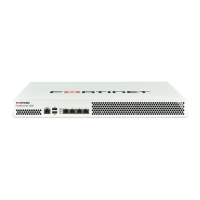System monitoring Page 90 FortiRecorder 2.4.2 Administration Guide
6. To verify your SNMP configuration and network connectivity between your SNMP manager
and your FortiRecorder appliance, be sure to test both traps and queries (assuming you
have enabled both). Traps and queries typically occur on different port numbers, and
therefore verifying one does not necessarily verify that the other is also functional. To test
queries, from your SNMP manager, query the FortiRecorder appliance. To test traps, cause
one of the events that should trigger a trap.
See also
• Configuring SNMP v3 users
• SNMP traps & queries
Configuring SNMP v3 users
If your SNMP manager supports SNMP v3, you can specify which of its user accounts is
permitted to access information about your FortiRecorder appliance. This provides greater
granularity of control over who can access potentially sensitive system information.
To specify access for an SNMP user via the web UI
1. Go to System > Configuration > SNMP.
2. If you have not already configured the agent, do so before continuing. See “To configure the
SNMP agent via the web UI”.
3. Under User, click New.
A dialog appears.
4. Configure these settings:
Setting name Description
User name Type the name of the SNMP user. This must match the name of the
account as it is configured on your SNMP manager.
You can add up to 16 users.
Enable Enable this user entry.
Security level Choose one of the three security levels:
• No authentication, no privacy — Causes SNMP v3 to behave
similar to SNMP v1 and v2, which provides neither secrecy nor
guarantees authenticity, and therefore is not secure. This option
should only be used on private management networks.
• Authentication, no privacy — Enables authentication only,
guaranteeing the authenticity of the message, but not safeguarding it
from eavesdropping. Also configure Authentication protocol.
• Authentication, privacy — Enables both authentication and
encryption, guaranteeing authenticity as well as secrecy. Also
configure Privacy protocol.
Authentication
protocol
Select either SHA-1 or MD5 hashes for authentication. Also configure a
salt in Password. Both the protocols and passwords on the SNMP
manager and FortiRecorder must match.
Privacy protocol
Select either AES or DES encryption algorithms. Also configure a salt in
Password. Both the protocols and passwords on the SNMP manager
and FortiRecorder must match.

